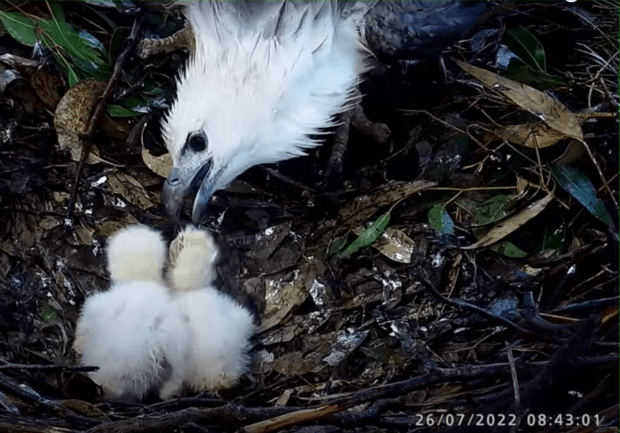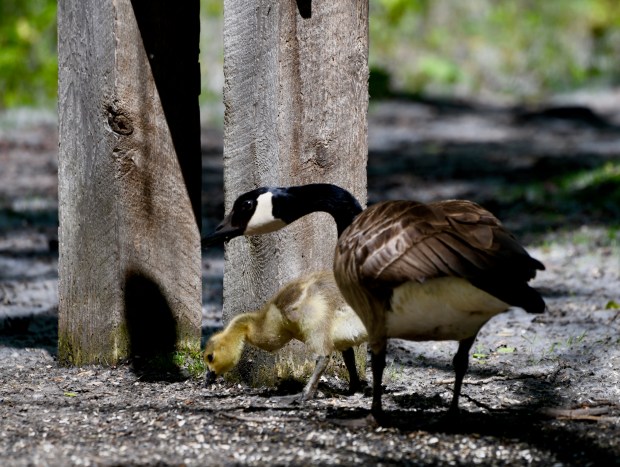27 July 2022

The presentation about Eagles Dying of Electrocution: What Can be Done? was quite informative. A number of topics were covered including why it is important for utility companies to not have wildlife incidents. Because they boost of having reliable electricity they cannot afford to have too many power outages due to wildlife electrocutions (squirrels, raptors, etc). So while wildlife is not their primary concern, if an eagle gets electrocuted it does impact their goal of ‘reliable’ transmission of power and it is actually in their best interests that their poles are safe. It is also good for their public image.
A PDF of a very large study done in 2006 was mentioned several times. It studied different birds in different countries with various configurations of hydro poles and how electrocution might be mitigated. Christian stated that the solutions are still solid examples. Here is a copy of that large study:
One interesting note in the mitigation is that you simply cannot install insulators or insulated cables. You must also deal with the transmitters.
A question or statement by one of the chatters for the presentation had to do with the lack of responsibility in this situation. If the first electrocution for an eaglet from the Gabriola Nest was accidental, isn’t the second one intentional? Many power companies will immediately move to fix the poles if they know there has been an incident. Florida has so many big raptors and it was mentioned that the power companies are pro-active in protecting the large birds.
An example from Belgium was shown. That is a perch for the eagle that is higher than the pole. The perch is not dangerous to the eagle. To mitigate further, the pointed triangle on the left has been installed making it impossible to create a connection also. Fantastic.

An example of good spacing and bad spacing in terms of wildlife.

Here is the presentation link in case you missed it or would like to listen again. It is about 50 minutes long.
Yvonne Roll Peterson posted the following image on the Notre Dame Eagles page. She carefully took the time to mark out who was where. You can’t see ND16, she is on the nest (of course). ND15 is on one branch and our Little Bit 17 is on another branch behind some leaves. Smile.

My eyes are on the Osoyoos Osprey nest where temperatures are climbing getting hotter and hotter. Olsen brought in a nice sized fish but it has been more than four hours ago. Hopefully they will get another. Soo is doing the best she can to try and keep her panting chicks shaded.



After the presentation on the Eagles and electrocution, I spent some time observing SE29 and SE30. SE30 did two ‘ps’ – one at 0634 and the other at 0713. Both were good. I did manage to capture one. Look carefully below.

Dad brought in what appeared to be a bird – possibly a Silver Gull chick? for the next feeding. Neither chick was that enthusiastic about eating at either feeding.

SE29 did hover but, there were no violent attacks at either the 0634 feeding or the later one right after 0715 ish. After SE30 did his ‘ps’ he did eat some bites.

Lady may have lots of prey items under the leaves. It is hard to tell but I did not see the piles of fish like I did when these two first hatched. So two good ‘ps’ to indicate that SE30 has been eating and its plumbing is working fine. Dad comes down to the nest and flies off – to go fishing from Lady and 29 & 30. Good luck!

At 0745 Dad returns with a large fish. SE29 did take exception when it appeared that 30 was going to get the first bites. In situations where the eldest sibling is trying to establish dominance, most of you will have seen them eating first and once they are full the second eats if there is prey left. It would appear that 29 is asserting that dominance.
It should be sorted out in a few days. Look for good ‘ps’ from 30. Lady continues to feed them almost every hour. All those little bites add up. In a week or a week and a bit, the feedings will show down because the eaglets will be eating more at each feeding.


Things remain really stable and good at the Boathouse Osprey nest in Maine. Dory is feeding the three chicks another good sized fish.

Every once in awhile you can catch one of the Ospreys at Mispillion Harbour on the perch today.

Duke has been bringing some really nice fish to the Barnegat Light Osprey nest in New Jersey. Daisy feeds the kids and winds up with a big crop herself. Oh, I would love to send that fish to Osoyoos! Wouldn’t you?


I have seen no news on the cause of Tom and Audrey’s chick suddenly dying at the Chesapeake Conservancy nest. Will continue to monitor. The adults have been on and off the nest.
Aran and Mrs G have been doing a lot of posing on the perches – sometimes with but today without the fledglings.
Notice the difference in size. Mrs G is at least one-third larger than Aran. Check out the difference in size in wings. — It is always good to remember, when watching a raptor nest, that the females require more food in order to grow to the larger size and to also grow all those additional feathers. Often the females are not the first to fledge either even if they hatched first.
The difference in size – where the females are larger than the males – is called reverse sex-size dimorphism.

I hope if you did not get to attend Christian Sasse’s presentation that you will take the chance to listen to it later. Some very good information with a lot of common sense when approaching utility companies. To all who wrote in, thank you.
Thank you for being with me this evening on this quick check. I am just watching two nests – Osoyoos and the Sea Eagles for stability. One for weather and the other for sibling rivalry. Fledge should be happening anytime at the Janakkalan Nest in Finland (or it has – have not checked today so if you know – send me a comment). Take care all. See you soon.
Thank you to the following for their videos, FB postings, and streaming cams where I took my screen captures: Christian Sasse, ND-LEEF, Osoyoos Ospreys, Sydney Sea Eagles@Birdlife Australia Discovery Centre, Sydney Olympic Park, Mispillion Harbour Ospreys and the DDNR, Barnegat Light Ospreys, Bywyd Gwyllt Glaslyn, and Audubon Explore.












































































































































